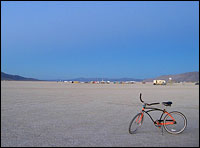The headline refers to a sign that appears as you drive (or as I drove, in a huge white pickup truck) into the Playa at five miles an hour, and it’s not a bad summary of the enviro discussion here at Burning Man. How can you really be green at an event you have to drive hundreds of miles to, mostly through desert, with all your heavy crap in the car? Where will all those plastic water bottles end up? Is there such thing as a petroleum-free camp? What about all those Zip Ties, the preferred technology for securing dome coverings and lights on your bike?
Is Burning Man this year anywhere close to carbon-free?
No, says Andie Grace, the woman who ably answers the media here. “We’re doing everything we can to lessen the footprint, but we can’t make it disappear. After all, to do that we’d all have to sit home, strip naked, and eat grubs.”
Which is not to say there isn’t good stuff going on here. Says BMan’s enviro czar Tom Price, “We are at or slightly ahead of our expectations. We switched 90 percent from red diesel, which comes from places like Saudi Arabia, to biodiesel that comes from Minden, Nevada.” (Problems with biodiesel clogging generator filters — which is does, because it scours out previous petroleum deposits in those gennies — have been resolved by changing filters.)
The Man, which is currently in the process of being rebuilt, is lighted with neon powered with a 30 kilowatt solar array, which also powers the entire man complex. It’s also powering the power tools the powerful construction people are using to rebuild the Man (which burned unexpectedly early Tuesday morning during the lunar eclipse. It was epic and historic, and a good time was had by all).
When that solar array, donated by Renewable Ventures, MMA, comes down on Saturday before the burn, “we’re going to build 120 kilowatts in the town of Gerlach,” says Price, “and 60 kilowatts in the town of Lovelock. That’s two million dollars in free renewable energy.”
Plus, once you get here, you ride your bike everywhere. Or your scooter. Or something. But you don’t drive your car for a week. As Burning Man founder Larry Harvey said, "that offsets something."
I will take this back after I’ve been home for a month, but right now, sitting here in my skimpy pink dress, using a solar-powered WiFi connection on my solar-powered laptop looking out that the spectacular Esplanade full of solar-powered art and just digging the ambient laughter and music of strangers, it seems like Burning Man really could change the … okay, okay. I’ll stop now.
Next post: How Albertson’s grocery store became a beacon of environmental ethics after its execs visited the Playa last year.



